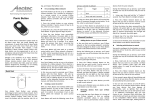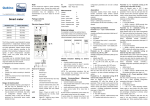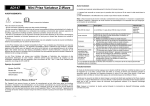Download Aeotec by Aeon Labs Key Fob. Familiarise yourself with your Key
Transcript
Aeotec by Aeon Labs Key Fob. View the expanded manual: http://aeotec.com/support Remote controls revolutionised the way we could do things. They changed the way we watch TV. They changed the way we listen to music. They even changed the way we park our cars. And then they stopped revolutionising and instead evolved to become more and more complex. They became bigger. They became weighed down with too many buttons, too many confusing things that you could do. Your Key Fob has four buttons. Each button offers different functionality depending on whether your remote is in Use or Setup mode. Aeotec’s Key Fob, from our Gen5 range of products, takes the remote back to where it began. It’s easy to use. It’s simple. It’s small. It’s there for when you need it and it’s out of sight for when you don’t. Familiarise yourself with your Key Fob. Package Contents: Key Fob Gen5 Battery Button pin Use Mode allows you to use your Key Fob to have full control of devices within your Z-Wave network. Use Mode can be changed to function as a Group or Scene controller. For further information on your Key Fob’s Use Mode, please refer to the section ‘Your Key Fob is a secondary controller’ under the section ‘Creating a scene to control’. Quick start. The first step to setting up your Key Fob is to power it up. These two modes have very different purposes: Setup Mode can be used to create a new Z-Wave network or to add or remove devices from an existing Z-Wave network. 1. Take the CR2450 battery out of the box. 2. Remove your Key Fob’s battery cover. 3. Insert the battery with the positive side (+) on top. 4. Reattach the battery cover. Your Key Fob is now powered on for the first time. As it’s the first time you’re using it, it is by default in Setup Mode. Now you need to either create a new Z-Wave network for your Key Fob to control, or to add it to your existing network. If you already have an existing Z-Wave network. During the following steps, your Key Fob should be in close to your primary Z-Wave controller. This is likely to be a gateway or hub. 1. Put your primary Z-Wave controller into inclusion mode. If you’re unsure of how to do this, refer to the part of its user manual that describes adding new Z-Wave devices to your network. 2. Press the Learn button on your Key Fob with the pin or press the bottomright action button. Your Key Fob’s green light will begin to pulse. 3. Once the controller and your Key Fob have successfully exchanged information, the green light on your remote will stay lit for 2 seconds. If the exchange of information fails, the red light on your remote will stay lit for 2 seconds. If this occurs, please repeat the process from step 1 ensuring that your primary Z-Wave controller is in inclusion mode. Your Key Fob will now work as a remote control within your Z-Wave network, allowing it to both control associated devices and act as a tool for adding devices to and removing devices from your Z-Wave network. Please skip to the ‘Change your remote’s mode’ section of this guide to continue. If you need to create a new Z-Wave network. Your Key Fob can be set up as the primary controller of a Z-Wave network. This is ideal for a situation where you don’t have an existing Z-Wave network setup, and you’re either starting out or intending to set up only a small network. To create a new Z-Wave network, you need to associate your Key Fob with any Z-Wave devices you want it to control this will set up a new Z-Wave network for you. These Z-Wave devices cannot be part of an existing network. To do this, refer to the section, ‘Adding devices to your Z-Wave network’ in the Advanced Functions part of this guide, and follow the instructions. Change your remote’s mode. Your Key Fob is now setup and is either part of an existing Z-Wave network or is the primary controller of a new Z-Wave network. For all the previous steps your Key Fob has been in Setup Mode. It’s now time to change it to Use Mode. This will allow your Key Fob to function as a remote control. 1. Slide to open the main panel of your Key Fob so that the buttons are revealed. 2. Press and hold the Mode button and Learn Button with 2 pins for 3 seconds. 3. Your remote’s red light will illuminate for 3 seconds, then the green light will stay solid for 1 second to confirm that the mode has been successfully changed. If, at a later stage, you wish to change your Key Fob back to Setup Mode, please repeat the previous steps. Creating a scene to control. Before giving your Key Fob control over other Z-Wave devices, it’s important to understand how many scenes each button can control. A scene is a grouping of multiple devices and each button on your Key Fob is capable of controlling multiple devices (aka a scene) with the push of a single button. If you set your Key Fob up as a primary controller in the previous steps by creating a new network, each button is capable of controlling 1 individual scene. If you added your Key Fob to an existing Z-Wave network, it can control either 1 or 2 individual scenes per button. The distinction here is whether your Key Fob is Use (Group) Mode or in Use (Scene) Mode. In Use (Group) Mode, you can control 1 scene from each button. In Use (Scene) Mode you can control 2 different scenes from each button. Please refer to the ‘Selecting which devices to control’ section of this guide for a step-by-step instruction on how to do this. Your Key Fob is a secondary controller. By default your Key Fob, when added to an existing network, is in Use (Group) Mode. To change the mode please refer to the ‘Setting your Key Fob’s use mode’ under the ‘Advanced Function’ section of this manual. Your Key Fob is in Use (Group) Mode. The following sections give directions on creating scenes relative to how your Key Fob is setup. In order to program each button of your Key Fob, please refer to the ‘Selecting which devices to control’ section of this guide. Your Key Fob is a primary controller. Your Key Fob is in Use (Scene) Mode. In this mode, each of the 4 different scenes which your Key Fob can control will need to be manually programmed. In this mode your Key Fob communicates directly with your Z-Wave network’s primary controller, generally a gateway or hub. By pressing each scene button, your Key Fob will send out a scene ID telling the primary controller to activate customized scenes that need to be setup via your controller’s interface. Please refer to your primary controller’s user manual for instructions on how to program individual scenes and how to activate these with your Key Fob. Using your Key Fob. With your Key Fob now setup, it’s time to use it. That’s as simple as pushing a button to activate or deactivate scenes. If your Key Fob is in Use (Scene) Model, the following table illustrates the button presses your remote will understand in order to control 8 different scenes with only 4 buttons. Button 1 1 2 Trigger Click Press and hold for 2 sec. Click 2 Press and hold for 2 sec. Scene ID 1 2 3 4 3 3 4 4 Click Press and hold for 2 sec. Click Press and hold for 2 sec. 5 6 7 8 Advanced functions. Adding devices to your Z-Wave network. Your Key Fob has been designed with the ability to add Z-Wave devices to its network. During the following set up process, you need to ensure that your Key Fob is in Setup Mode. Refer to ‘Change your remote’s mode’ for instructions on how to change modes. 1. Press the include button, your Key Fob’s green light will pulse slowly. 2. Press the Z-Wave button on the device that you wish to add. If you’re unsure of how to do this, refer to its user manual. 3. Once the inclusion is successful, the green light on your Key Fob will stay lit for 2 seconds and then blink again. Otherwise, the red light on your Key Fob will stay lit for 2 seconds before the green light blinks again. 4. Repeat step 2 for any other devices you wish to add to your network. 5. Once you’re finished, press any button on your Key Fob to exit this mode. Removing devices from your Z-Wave network. Your Key Fob is capable of removing devices from your Z-Wave network when it is either your network’s primary controller or your network permits your Key Fob, as a secondary controller, to permanently remove devices. 1. Press your Key Fob’s remove button. Your Key Fob’s red light will pulse slowly. 2. Press the Z-Wave button on the device that you wish to remove. If you’re unsure of how to do this, refer to its user manual. 3. If the removal is successful, the green light on your Key Fob will stay lit for 2 seconds and then its red light will blink. Otherwise, the red light will stay lit for 2 seconds before again blinking. 4. Repeat step 2 for any other devices you wish to remove from your network. 5. Once you’re finished, press any button on your Key Fob to exit removal mode. Selecting which devices to control. Your Key Fob has two use modes, Scene Mode and Group Mode. When in Scene Mode, your select which devices your Key Fob can control by using your primary controller, generally a gateway or a hub. If in Group Mode, you configure your Key Fob to directly control devices as follows; 1. Press and hold your Key Fob button that you wish to use to control a Z-Wave device. Do not release the button until step 4. Your Key Fob’s green light will blink rapidly when it’s ready for the following steps. 2. Press the Z-Wave button on the device that you wish to control. If you’re unsure of how to do this, refer to its user manual. If your Key Fob is able to control the Z-Wave device, its green light will stop blinking and remain solid for 2 seconds. If the Z-Wave device cannot be controlled, its green light will still keep blinking or its red light will blink only once when you short press the Z-Wave button. 3. Before you release the button, you must determine what you want it to do. a) If the Z-Wave device that you want to control is ON when you release the button, it will toggle the Z-Wave device on and off. b) If the Z-Wave device that you want to control is OFF when you release the button, it will only allow you to turn the Z-Wave device off. c) If the Z-Wave device that you want to control is at a PERCENTAGE (ie. 20%, 35%, 70% power) when you release the button, it will allow it you toggle the Z-Wave device between that percentage and off. 4. Release the button you held down in step 1. 5. Repeat the steps above if you wish to control more Z-Wave devices from your Key Fob. You can add multiple devices to each button in order to create a scene. You can add up to 40 Z-Wave devices to each button. Removing devices from a button. You can disassociate Z-Wave devices from a button on your Key Fob when it’s in Group Mode. If you wish to do this; 1.Press and hold the button that you want to remove control of the Z-Wave device from. Your remote’s green light will blink rapidly when it’s ready to continue. 2. Press the Z-Wave button on the device. If you’re unsure of how to do this, refer to its user manual. 3. If the device has been disassociated, your Key Fob’s green light will stop blinking and the red light will stay illuminated. 4. Release the button you held down in step 1. 5. Repeat the above steps to remove other Z-Wave devices. Resetting your Key Fob. Your Key Fob can be reset to default factory settings with ease. Please use this procedure only when your primary controller is missing or otherwise inoperable. 1. Press and hold the Mode button for 20 seconds with a pin. 2. The green and red light will alternate for 20 seconds, then the green light will stay solid for 2 seconds to indicate a successful reset. Setting your Key Fob’s use mode. Each brand of Z-Wave gateway / hub has its own unique method for setting your Key Fob’s user mode as a Group or Scene controller. Please refer to your gateway’s user manual for detailed instructions on this. In some cases, you will need to utilise the technical parameter settings available in your Key Fob. 1. Go to the parameter settings page, specific to your Key Fob, within your gateway’s user interface. 2. If it does not already exist, add a new row or column to add Parameter number 250. 3. Set the size of the parameter to be 1 byte. 4. Set the value in order to place your Key Fob into Group or Scene Mode. Group Mode has a value of 0, Scene Mode has a value of 1. Technical specifications. Model Number: ZW088 Battery: lithium cell CR2450 3 volt battery Operating temperature: -10 C to 50 C Relative humidity: 8% to 80% Operating distance: Up to 300 feet/100 metres outdoors. 6 Warranty. Aeon Labs warrants to the original purchaser of Products that for the Warranty Period (as defined below), the Products will be free from material defects in materials and workmanship. The foregoing warranty is subject to the proper installation, operation and maintenance of the Products in accordance with installation instructions and the operating manual supplied to Customer. Warranty claims must be made by Customer in writing within thirty (30) days of the manifestation of a problem. Aeon Labs' sole obligation under the foregoing warranty is, at Aeon Labs' option, to repair, replace or correct any such defect that was present at the time of delivery, or to remove the Products and to refund the purchase price to Customer. The "Warranty Period" begins on the date the Products is delivered and continues for 12 months. Any repairs under this warranty must be conducted by an authorized Aeon Labs service representative and under Aeon Labs' RMA policy. Any repairs conducted by unauthorized persons shall void this warranty. Excluded from the warranty are problems due to accidents, acts of God, civil or military authority, civil disturbance, war, strikes, fires, other catastrophes, misuse, misapplication, storage damage, negligence, electrical power problems, or modification to the Products or its components. Aeon Labs does not authorize any person or party to assume or create for it any other obligation or liability in connection with the Products except as set forth herein. Aeon Labs will pass on to Customer all manufacturers’ Material warranties to the extent that they are transferable, but will not independently warrant any Material. Customer must prepay shipping and transportation charges for returned Products, and insure the shipment or accept the risk of loss or damage during such shipment and transportation. Aeon Labs will ship the repaired or replacement products to Customer freight prepaid. Customer shall indemnify, defend, and hold Aeon Labs and Aeon Labs' affiliates, shareholders, directors, officers, employees, contractors, agents and other representatives harmless from all demands, claims, actions, causes of action,proceedings, suits, assessments, losses, damages, liabilities, settlements, judgments, fines, penalties, interest, costs and expenses (including fees and disbursements of counsel) of every kind (i) based upon personal injury or death or injury to property to the extent any of the foregoing is proximately caused either by a defective product (including strict liability in tort) or by the negligent or willful acts or omissions of Customer or its officers, employees, subcontractors or agents, and/or (ii) arising from or relating to any actual or alleged infringement or misappropriation of any patent, trademark, mask work, copyright, trade secret or any actual or alleged violation of any other intellectual property rights arising from or in connection with the products, except to the extent that such infringement exists as a result of Aeon Labs' manufacturing processes. IN NO EVENT SHALL AEON LABS BE LIABLE FOR ANY INDIRECT, INCIDENTAL, PUNITIVE, SPECIAL OR CONSEQUENTIAL DAMAGES, OR DAMAGES FOR LOSS OF PROFITS, REVENUE, OR USE INCURRED BY CUSTOMER OR ANY THIRD PARTY, WHETHER IN AN ACTION IN CONTRACT, OR TORT, OR OTHERWISE EVEN IF ADVISED OF THE POSSIBILITY OF SUCH DAMAGES. AEON LABS' LIABILITY AND CUSTOMER'S EXCLUSIVE REMEDY FOR ANY CAUSE OF ACTION ARISING IN CONNECTION WITH THIS AGREEMENT OR THE SALE OR USE OF THE PRODUCTS, WHETHER BASED ON NEGLIGENCE, STRICT LIABILITY, BREACH OF WARRANTY, BREACH OF AGREEMENT, OR EQUITABLE PRINCIPLES, IS EXPRESSLY LIMITED TO, AT AEON LABS' OPTION, REPLACEMENT OF, OR REPAYMENT OF THE PURCHASE PRICE FOR THAT PORTION OF PRODUCTS WITH RESPECT TO WHICH DAMAGES ARE CLAIMED. ALL CLAIMS OF ANY KIND ARISING IN CONNECTION WITH THIS AGREEMENT OR THE SALE OR USE OF PRODUCTS SHALL BE DEEMED WAIVED UNLESS MADE IN WRITING WITHIN THIRTY (30) DAYS FROM AEON LABS'S DELIVERY, OR THE DATE FIXED FOR DELIVERY IN THE EVENT OF NONDELIVERY. THE INDEMNITY AND WARRANTY IN ABOVE ARE EXCLUSIVE AND IN LIEU OF ALL OTHER INDEMNITIES OR WARRANTIES, WHETHER EXPRESS OR IMPLIED, INCLUDING THE IMPLIED WARRANTIES OF MERCHANTABILITY AND FITNESS FOR A PARTICULAR PURPOSE. FCC NOTICE (for USA) THE MANUFACTURER IS NOT RESPONSIBLE FOR ANY RADIO OR TV INTERFERENCE CAUSED BY UNAUTHORIZED MODIFICATIONS TO THIS EQUIPMENT.SUCH MODIFICATIONS COULD VOID THE USER’S AUTHORITY TO OPERATE THE EQUIPMENT. STORE INDOORS WHEN NOT IN USE. SUITABLE FOR DRY LOCATIONS. DO NOT IMMERSE IN WATER. NOT FOR USE WHERE DIRECTLY EXPOSED TO WATER. This device complies with Part 15 of the FCC Rules. Operation is subject to the following two conditions: 1. This device may not cause harmful interference, and 2. T h i s d e v i c e m u s t a c c e p t a n y interference received, including interference that may cause undesired operation. This equipment has been tested and found to comply with the limits for a Class B digital device, pursuant to part 15 of the FCC Rules. These limits are designed to provide reasonable protection against harmful interference in a residential installation. This equipment generates, uses and can radiate radio frequency energy and, if not installed and used in accordance with the instructions, may cause harmful interference to radio communications. However, there is no guarantee that interference will not occur in a particular installation. If this equipment does cause harmful interference to radio or television reception, which can be determined by turning the equipment off and on, the user is encouraged to try to correct the interference by one or more of the following measures: Reorient or relocate the receiving antenna. Increase the separation between the equipment and receiver. Connect the equipment into an outlet on a circuit different from that to which the receiver is connected. Consul the dealer or an experienced radio/TV technician for help. Warning Do not dispose of electrical appliances as unsorted municipal waste, use separate collection facilities. Contact your local government for information regarding the collection systems available. Certifications (regional): Z-Wave and Z-Wave Plus are registered trademarks of Sigma Designs and its subsidiaries in the United States and other countries Version:501008800001-AA www.aeotec.com Aeon Labs Key Fob Gen5 (Z‐Wave Aeon Labs Key Fob) Change history Revision Date 1 05/14/2013 Change Description Initial draft. 2 08/11/2014 Update Z‐wave module to 500 series 3 09/20/2014 Modify battery Level 4 10/27/2014 Add Association Group Info CC V1 Aeon Labs Key Fob Engineering Specifications and Advanced Functions for Developers (V1.01) Aeon Labs Key Fob is a fully functional Z‐Wave remote control capable of adding, removing and controlling other Z‐Wave devices. It can also become a secondary or inclusion controller to a SIS gateway in the Z‐Wave network. Form‐factor, industrial design and robust functionality are the major foci. 1. Library and Command Classes 1.1 SDK: 6.51.00 1.2 Library Role Type: Portable Controller(PC) Generic Device class: GENERIC_TYPE_ GENERIC _CONTROLER Specific Device Class: SPECIFIC_TYPE_PORTABLE_REMOTE_ CONTROLER 1.3 Commands Class COMMAND_CLASS_ZWAVEPLUS_INFO V2 COMMAND_CLASS_VERSION V2 COMMAND_CLASS_MANUFACTURER_SPECIFIC V2 COMMAND_CLASS_CONFIGURATION V1 COMMAND_CLASS_BATTERY V1 COMMAND_CLASS_ASSOCIATION V1 COMMAND_CLASS_ASSOCIATION_GRP_INFO V1 COMMAND_CLASS_POWERLEVEL V1 COMMAND_CLASS_DEVICE_RESET_LOCALLY V1 COMMAND_CLASS_WAKE_UP V2 COMMAND_CLASS_MARK V1 COMMAND_CLASS_SCENE_ACTIVATION V1 COMMAND_CLASS_SWITCH_MULTILEVEL V1 2. Technical Specifications Operating Distance: Up to 300 feet (100 meters) outdoors. 3. Familiarize Yourself with Your Key Fob Gen5 3.1 Interface 4. Key Fob Supported Mode functions 4.1 Setup Mode Functions Button Include Remove Learn Description/Functions Short press the “Include” button, the Key Fob will go into inclusion state and its blue LED will blink slowly to wait including any other Z‐wave device in its network. Short press the “Remove” button, the Key Fob will go into exclusion state and its red LED will blink slowly to wait excluding any other Z‐wave device from its network. Short press the “Learn” button, the Key Fob’s blue LED will blink slowly, which means the Key Fob will be acted as a secondary controller to be added into the other primary controller. 4.2 Group/Scene Mode Functions The default mode of Key Fob is Setup Mode. You can press and hold the “Learn” button and “Mode” button for 3 seconds to change its Setup Mode to Use Mode. In Use Mode, it also contains 2 modes that are Group Mode and Scene Mode. The default mode of Use Mode is Group Mode. You can also change the Group Mode to Scene Mode via setting the configuration parameter 250 to 1. Use Mode Group Scene In Scene Mode: Button 1 2 3 4 Description If your Key Fob is in Group Mode, you can control 40 different Z‐Wave devices with each of your remote’s 4 buttons, If you don’t know how to use it, please refer to the manual. If you Key Fob is in Scene Mode, the 4 control buttons will be acted as 4 scene buttons and each of button can control 2 different scenes. Both of scenes can associate to 5 Z‐Wave devices. If you don’t know how to use it, please refer to the manual. Trigger Scene ID Click 1 Press and hold 2 seconds 2 Click 3 Press and hold 2 seconds 4 Click 5 Press and hold 2 seconds 6 Click 7 Press and hold 2 seconds 8 5. Special Rule of each Command 5.1 Association Command Class The Key Fob can be setup to send Scene Activation Set CC to any given nodes that have been set and associated by Key Fob within its own network. It supports only 1 association group. When you set the association to other nodes, you must firstly set association to node 1(sis). 5.2 Wake Up Command Class After a successful “learn” process, the Key Fob is added into another primary controller and it will stay awake for 30 seconds that can receive any other commands from other nodes at this time. Alternatively, press and hold the “Learn” button for 3 seconds, which will send a “Wake Up Notification CC” with broadcast and stay awake for 8 seconds. 5.3 Z‐Wave Plus Info Report Command Class Parameter Value Z‐Wave Plus Version 1 Role Type 2 (ZWAVEPLUS_INFO_REPORT_ROLE_TYPE_CONTROLLER_PORTABLE) Node Type 0 (ZWAVEPLUS_INFO_REPORT_NODE_TYPE_ZWAVEPLUS_NODE) Installer Icon Type 0x0A00 (ICON_TYPE_GENERIC_REMOTE_CONTROL_MULTI_PURPOSE) User Icon Type 0x0A00 (ICON_TYPE_GENERIC_REMOTE_CONTROL_MULTI_PURPOSE) 5.4 Association Group Info Command Class 5.4.1 Association Group Info Report Command Class Profile: General: NA (Profile MSB=0, Profile LSB=0) 5.4.2 Association Group Name Report Command Class Group 1: Lifeline 5.3Configuration Set Command Class 7 6 5 4 3 2 1 0 Command Class = COMMAND_CLASS_CONFIGURATION Command = CONFIGURATION_SET Parameter Number Default Reserved Size Configuration Value 1(MSB) Configuration Value 2 ……… Configuration Value n(LSB) Parameter Number Definitions (8 bit): Parameter Description Number Enable selective Group Mode or Scene Mode when the 250 Key Fob is in Use mode.(0==Group Mode,1==Scene Mode) Default Value Size 0 1 255 Reset configuration set up to default setting. N/A 1 6. Reset Key Fob to Default Setting If you want to reset your Key Fob, press and hold the Mode button 20 seconds. If successful, after 20 seconds, the green Led will illuminate for 2 seconds and then off. Otherwise, repeat the process again. Please use this procedure only when your primary controller is missing or otherwise inoperable.




















